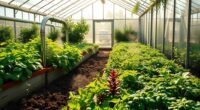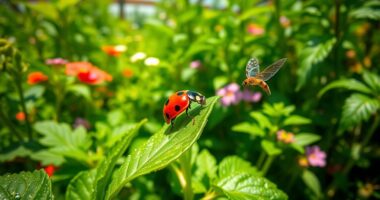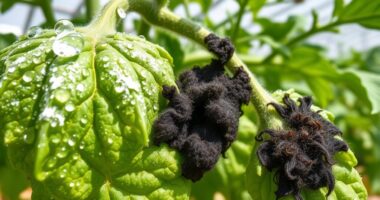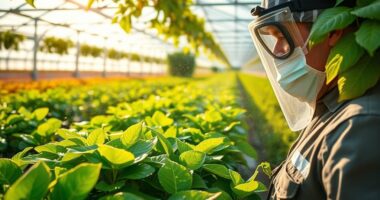To identify and treat fungal diseases in your greenhouse, look for symptoms like yellowing leaves, fuzzy growth, or lesions. Causes often include warm, humid conditions and overcrowded plants. To prevent issues, improve air circulation, manage humidity, and rotate crops. For treatment, consider fungicides, biofungicides, or natural remedies like neem oil. Always maintain sanitation and inspect your plants regularly. Stay tuned, and you'll discover more effective strategies to keep your greenhouse healthy.
Key Takeaways
- Monitor plants regularly for symptoms like yellowing leaves, lesions, or powdery substances to identify fungal diseases early.
- Ensure proper ventilation and reduce humidity in greenhouses to prevent fungal growth conditions.
- Use resistant plant cultivars and rotate crops to minimize the risk of fungal infections.
- Apply fungicides or biofungicides at the first sign of disease for effective treatment.
- Keep tools and surfaces disinfected, and remove infected plants promptly to limit disease spread.
Common Fungal Diseases in Greenhouses

When you're managing a greenhouse, being aware of common fungal diseases is crucial for maintaining plant health.
Black rot can blacken plant tissues, often leading to death.
Black rot can severely damage plants, causing tissue blackening and often resulting in plant death.
Botrytis blight, or gray mold, thrives in humid conditions and affects a variety of plants.
Downy mildew targets leaves, causing yellowing and a fuzzy growth underneath.
Fusarium root and stem rot can cause wilting and eventual collapse, while Phytophthora root rot leads to decay, frequently resulting in plant death due to overly wet conditions.
Identifying these diseases early is critical.
Look for symptoms like discoloration, wilting, or abnormal growth.
Being proactive helps protect your crops and maintain the health of your greenhouse environment.
Causes of Fungal Growth in Greenhouses
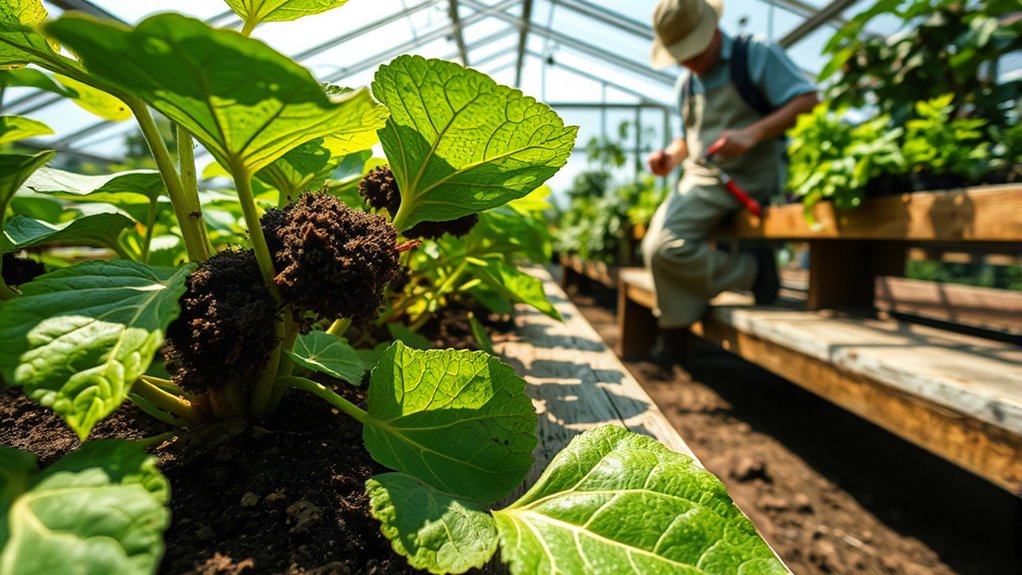
Fungal diseases in greenhouses thrive under specific conditions that create an environment ripe for their growth. Warm, humid conditions are ideal, as high humidity encourages spore germination.
Contaminated soil and potting mixes often harbor pathogens like Fusarium and Pythium, while waterborne pathogens can enter through irrigation. Poor air circulation traps moisture, further promoting fungal development.
Overcrowded plants reduce airflow and increase moisture retention, making conditions even more favorable for fungus. Additionally, inadequate sanitation can spread spores, and using infected seeds introduces diseases right from the start.
To prevent fungal growth, maintain proper water management, guarantee good air circulation, and regularly sanitize tools and surfaces. By addressing these causes, you can considerably reduce the risk of fungal infections in your greenhouse.
Symptoms of Fungal Diseases
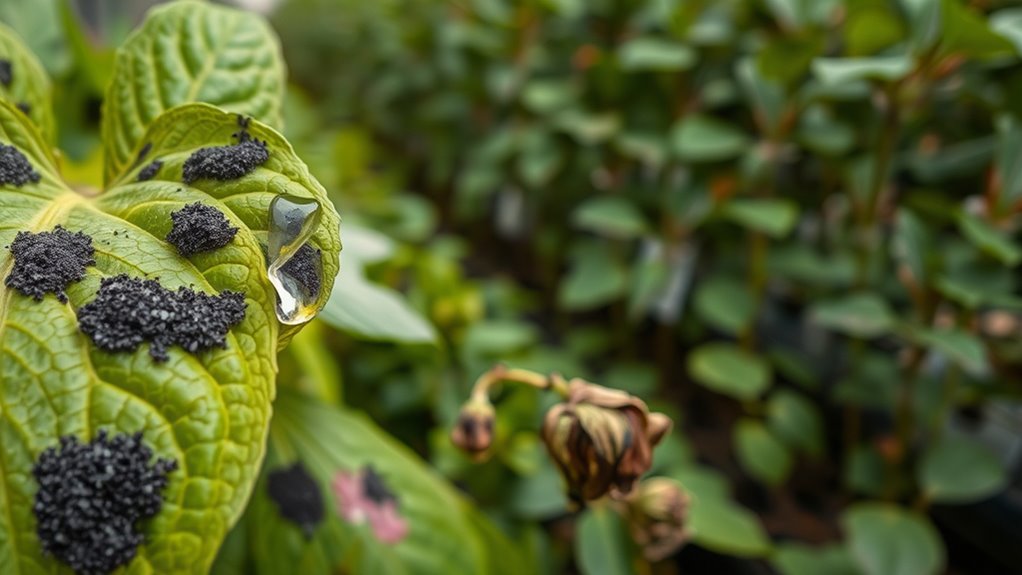
Recognizing the symptoms of fungal diseases in your greenhouse is essential for maintaining plant health.
Identifying fungal disease symptoms early is crucial for ensuring the health of your greenhouse plants.
Look for Botrytis Blight, where leaves and flowers turn yellow and develop brown lesions.
Rust appears as orange or yellow patches on leaves, stems, and fruits.
You might notice Powdery Mildew as a white or gray powdery substance on your plants.
Fusarium Root and Stem Rot causes wilting and mushy roots.
Anthracnose shows up as spots and circular ulcers.
Additionally, Black Spot creates black spots on leaves leading to defoliation, while Downy Mildew results in yellowing leaves with white, cottony growth underneath.
Identifying these symptoms early can help you take action before the disease spreads and causes more severe damage.
Prevention Strategies

To keep your greenhouse thriving, it's crucial to implement effective prevention strategies against fungal diseases.
Start by ensuring proper ventilation and managing temperatures to reduce humidity levels, which fosters fungal growth. Avoid standing water and use shading materials to improve air circulation.
Regularly remove infected plants and disinfect tools and surfaces to limit pathogen spread. Consider growing resistant cultivars and rotating crops to minimize disease susceptibility.
Use soilless media to prevent introducing pathogens and monitor your irrigation to avoid overwatering.
Finally, maintain a holistic approach by combining sanitation, resistant varieties, and regular inspections to catch potential issues early. These proactive measures will help maintain a healthy environment for your plants.
Treatment Options
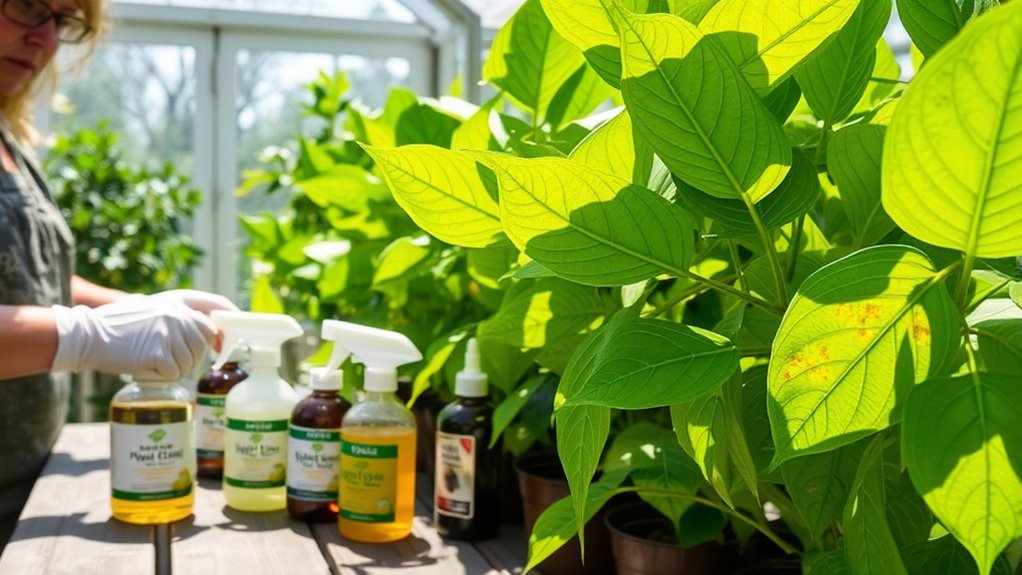
When faced with fungal diseases in your greenhouse, it's essential to explore a variety of treatment options to effectively manage and control the issue.
You can start with chemical treatments like fungicides, applying them at the first sign of disease while ensuring label compliance.
Consider using biofungicides, which contain living organisms that work best preventively.
For natural remedies, try baking soda solutions or neem oil for their antifungal properties.
Environmental modifications, like managing humidity and improving air circulation, can also be beneficial.
Finally, an integrated management system combining these methods will enhance effectiveness.
An integrated management system that combines various treatment methods will significantly boost your greenhouse's effectiveness against fungal diseases.
Always monitor your plants and maintain sanitation practices to keep your greenhouse healthy and thriving.
Diagnostic Techniques
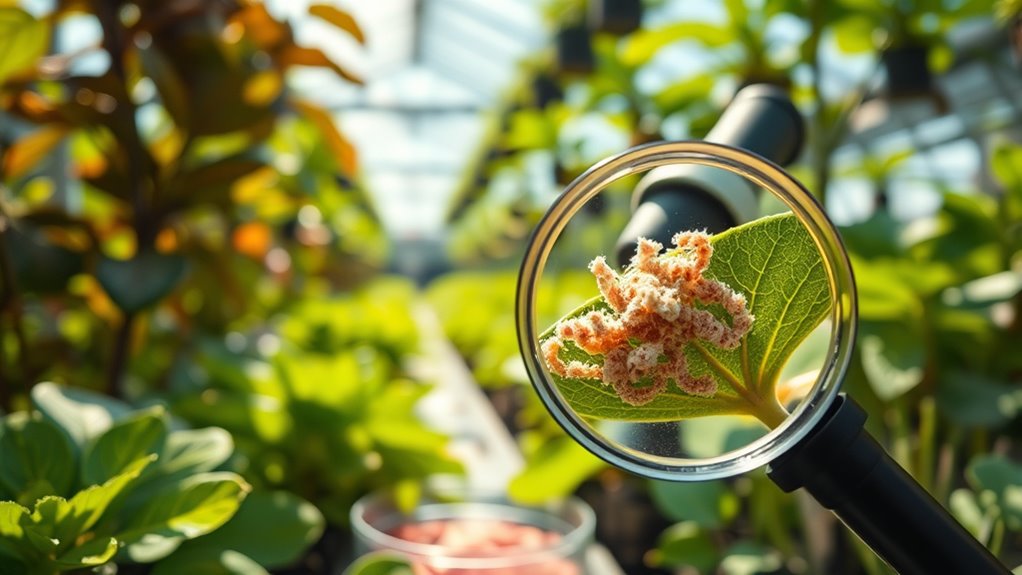
Effective treatment of fungal diseases hinges on accurate diagnosis. You can utilize various diagnostic techniques to identify the presence of fungi in your greenhouse.
For rapid detection, consider using CMOS image sensors and diffraction fingerprint feature processing to classify fungal spores effectively. Additionally, portable spore traps can help collect spores, although they won't separate pathogenic ones.
For quicker results, ELISA test kits can detect specific fungi like Phytophthora in about ten minutes. On-site tests offer a cost-effective option, providing quick results that allow for timely management decisions.
If you're looking for more advanced methods, Oxford Nanopore MinION sequencing can help analyze microbial communities in irrigation water for a thorough understanding of fungal presence.
Importance of Sanitation

Sanitation plays an essential role in maintaining a healthy greenhouse environment, as it directly impacts disease prevention and crop productivity. Pathogens like fungi, bacteria, and viruses can thrive on tools, clothes, and in soil.
By implementing effective sanitation practices, you can considerably reduce the risk of disease spread. Regularly removing infected tissue, cleaning equipment, and sterilizing growing media are vital steps in keeping your greenhouse pathogen-free. A clean environment not only lowers the need for chemical controls but also enhances crop health and reduces economic losses.
Furthermore, proper sanitation supports long-term sustainability by minimizing pesticide resistance and promoting biological control measures. Prioritizing sanitation guarantees a healthier, more productive greenhouse for you and your plants.
Integrated Pest Management (IPM)
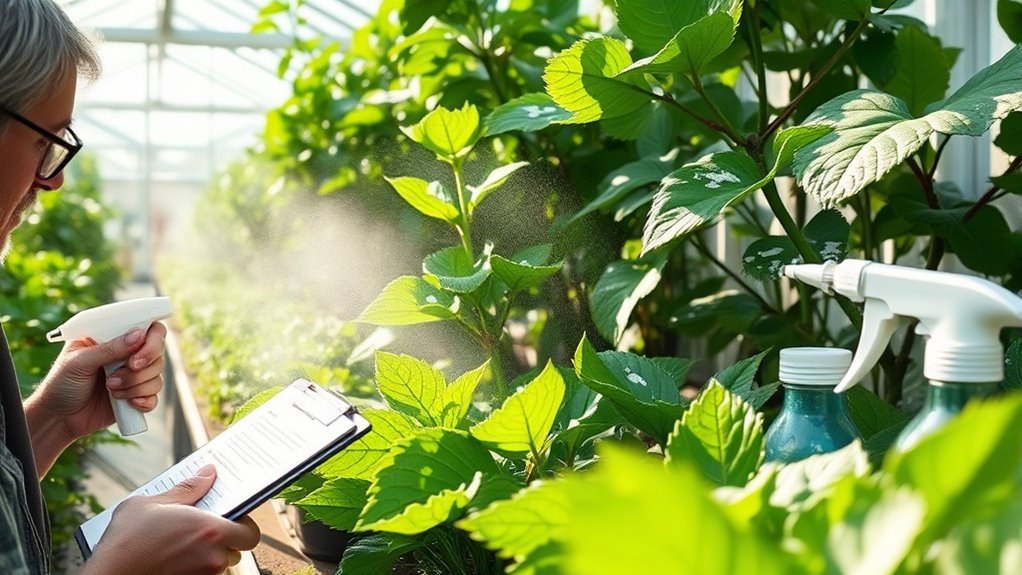
Integrated Pest Management (IPM) is a holistic approach that empowers you to tackle pests and diseases in your greenhouse effectively. By combining cultural, physical, biological, and chemical methods, you can reduce pest populations while minimizing environmental and health risks.
Start with monitoring techniques like sticky cards and regular inspections to identify pests early. Use beneficial organisms, such as predatory mites, for long-term pest control.
Implement cultural practices, like crop rotation and well-drained soil, to prevent pest buildup. Reserve chemical interventions for severe infestations, opting for biorational pesticides when needed.
Keep accurate records of pest populations and management efforts to improve your strategies over time. Adopting IPM can lead to healthier plants and cost savings in your greenhouse.
Frequently Asked Questions
How Do Environmental Factors Influence Fungal Disease Outbreaks?
Environmental factors considerably influence fungal disease outbreaks.
When you maintain high humidity and moderate temperatures, you create ideal conditions for fungal growth. If air circulation is poor, moisture gets trapped, increasing risks.
Overwatering can also promote fungi, so it's crucial to manage water carefully.
Additionally, low light intensities can favor diseases like powdery mildew.
Can Certain Plant Varieties Resist Fungal Infections?
Sure, you could just throw your plants in a fungal spa and hope for the best, but why not consider that some plant varieties are actually born with a superhero cape?
Yep, certain hybrids can resist fungal infections like a pro! By harnessing their natural defenses or using genetic tweaks, these plants stand tall against pesky fungi.
How Often Should I Monitor for Fungal Diseases?
You should monitor for fungal diseases daily during the establishment phase of your plants. This helps you catch early signs of issues like damping-off.
Once established, a weekly monitoring schedule is usually enough to detect any problems. For less susceptible crops, bi-weekly checks can suffice.
Always adjust your monitoring frequency based on environmental conditions, and increase your vigilance after any outbreaks to guarantee the diseases don't return.
Regular checks keep your plants healthy.
What Role Does Crop Rotation Play in Managing Fungal Diseases?
Crop rotation plays an essential role in managing fungal diseases by breaking the disease cycle.
By changing plant families, you deny pathogens a consistent host, effectively reducing their populations. This practice enhances soil health and nutrient availability, making it less favorable for fungal growth.
You'll find that implementing a well-planned rotation can lead to increased yields and improved disease resistance, all while promoting sustainable farming practices.
It's an effective, cost-efficient strategy for long-term health.
Are There Specific Signs of Fungal Disease in Seedlings?
You'll notice specific signs of fungal disease in seedlings, like wilting or a water-soaked appearance at the base of the stem, indicating damping-off.
Look for brown or black lesions around the soil line, which suggest infections like Rhizoctonia. If seedlings exhibit circular patterns of decline, it's a red flag.
Root decay mightn't always be visible, but it can severely impact growth. Staying vigilant helps you catch these issues early.
Conclusion
In a greenhouse, vibrant plants thrive alongside the lurking threat of fungal diseases. By staying vigilant and recognizing the symptoms early, you can protect your lush oasis from decay. Embracing prevention strategies, like proper sanitation and integrated pest management, keeps your plants flourishing while minimizing risks. Remember, a healthy greenhouse is a balance of life and vigilance—a vivid landscape of green energy, countered by the shadow of potential fungal invaders. Cultivate both beauty and awareness for a thriving environment.

